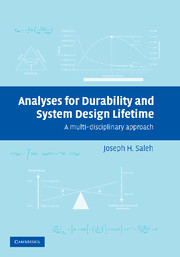Book contents
- Frontmatter
- Contents
- Preface
- 1 Introduction: On Time
- 2 To Reduce or to Extend Durability? A Qualitative Discussion of Issues at Stake
- 3 A Brief History of Economic Thought on Durability
- 4 Analysis of Marginal Cost of Durability and System Cost per Day
- 5 Flawed Metrics: System Cost per Day and Cost per Payload
- 6 Durability Choice and Optimal Design Lifetime for Complex Engineering Systems
- EPILOGUE: Perspectives in Design: The Deacon's Masterpiece and Hundred-Year Aircraft, Spacecraft, and Other Complex Engineering Systems
- APPENDIX A Beyond Cost Models, System Utility or Revenue Models: Example of a Communications Satellite
- APPENDIX B On Durability and Economic Depreciation
- Index
- References
3 - A Brief History of Economic Thought on Durability
Published online by Cambridge University Press: 25 October 2009
- Frontmatter
- Contents
- Preface
- 1 Introduction: On Time
- 2 To Reduce or to Extend Durability? A Qualitative Discussion of Issues at Stake
- 3 A Brief History of Economic Thought on Durability
- 4 Analysis of Marginal Cost of Durability and System Cost per Day
- 5 Flawed Metrics: System Cost per Day and Cost per Payload
- 6 Durability Choice and Optimal Design Lifetime for Complex Engineering Systems
- EPILOGUE: Perspectives in Design: The Deacon's Masterpiece and Hundred-Year Aircraft, Spacecraft, and Other Complex Engineering Systems
- APPENDIX A Beyond Cost Models, System Utility or Revenue Models: Example of a Communications Satellite
- APPENDIX B On Durability and Economic Depreciation
- Index
- References
Summary
PREVIEW AND GUIDE TO THE CHAPTER
This chapter provides an overview of economic thought on durability. The history of the dynamics and evolution of the durability choice problem is broken into four periods: (1) the origins and preanalytic period, (2) the flawed analytic period, (3) the Swan-centric period, and (4) the identification of the time inconsistency problem for durable goods monopolists. The narrative thread shows interesting cycles and a pattern of rise and then stumbling, followed by a more subtle and careful development of an economic theory of durability. The chapter concludes with a discussion of the present limitations in this literature.
Introduction: Snapshot From the Middle of the Story
In a review article on the effects of market structure on the choice of product durability, Richard Schmalensee (1979) concludes his survey by discouraging further research into this area and suggests that “the study of durability may have encountered strongly diminishing returns.”
Despite his warning, many scholars continued to investigate issues of durability, and major contributions were made in this area in the next two decades by economists including Jeremy Bulow (1982, 1986), Nancy Stokey (1981, 1988), and Michael Waldman (1993, 1996), to name a few.
Schmalensee's comments were in part justified because economists had focused too much, for too long, and almost exclusively on the assumptions underlying Peter Swan's counterintuitive result that product durability is invariant to market structure, or, more simply, that manufacturers of durable goods make the same choice of product durability irrespective of whether they are under competitive market conditions or monopoly (Swan, 1970, 1971, 1972; Sieper and Swan, 1973).
- Type
- Chapter
- Information
- Analyses for Durability and System Design LifetimeA Multidisciplinary Approach, pp. 24 - 52Publisher: Cambridge University PressPrint publication year: 2007



